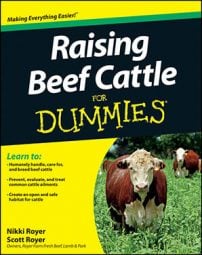Sure, you can provide your beef cattle with medical care when it gets sick or hurt, but preventing disease and injury in the first place is even better. Practice the following measures to keep niggling beef cattle concerns from morphing into big problems:
Provide a stress-free environment for your animals. Stress makes any living creature more susceptible to disease, and beef cattle are no exception. So take the time to always interact with your cattle in a calm and low-stress fashion.
Monitor your animal’s feed consumption. Decreased appetite is an early sign of sickness. Healthy cattle come up to the feed trough at every meal to eat. Healthy beef cattle on pasture have full and rounded stomachs.
Keep an eye out for changes in vital signs. For mature cattle, the normal temperature range is 100.4–103.1 degrees Fahrenheit, the pulse is 40–80 beats per minute, and the respiration rate at rest is 10–30 breaths per minute.
Create a vaccination schedule for your cattle and follow it. Implement an immunization schedule for respiratory and clostridial diseases. If you have breeding animals, you also want to have a reproductive vaccination program. Many fairly priced and highly effective vaccines are on the market.
Be sure to read and follow all label directions when giving shots.
Develop a good working relationship with your veterinarian. Your vet can be a great adviser as you strive to keep your herd of beef cattle in tip-top shape.

